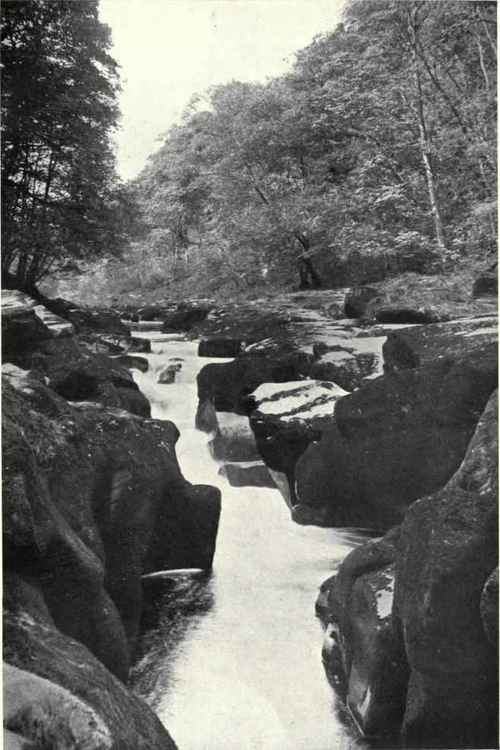Section XII. Flowers Of The Rocks, Walls, Stony And Gravelly Places
Description
This section is from the book "British Wild Flowers - In Their Natural Haunts Vol5-6", by A. R. Horwood. Also available from Amazon: A British Wild Flowers In Their Natural Haunts.
Section XII. Flowers Of The Rocks, Walls, Stony And Gravelly Places
We have already alluded, under Section VI on Mountains, Hills, and Dry Places, to certain Lithophytes, chiefly surface plants, which were grouped together primarily on a physical basis- - their altitude. In this section we include not only the surface plants (Exochomo-phytes) but true Lithophytes. Rock plants may be called Petrophytes, and include Lithophytes and Chomophytes. Here, also, as a subdivision of the latter, are some crevice plants growing in vertical fissures in rocks, or Chasmophytes.
As the group is kindred in character to, but diverse in origin from, the plants found on walls with the rupestral plants, a number of purely mural plants are included, and a few found on sandy or gravelly fields, of a local character, allied to those growing on rubble or shingle, but not identical. Several features characterize the existence of vegetation on rocks.
The plants are lovers of dry soil, and may be called in general rupestral or saxicolous. There are about 180 of these, and of that number 120 are alpine, 60 lowland species. Those here alluded to chiefly belong to the latter. About a dozen prefer wet rocks, and twenty are distinctly calciphilous or lime-lovers, and so on. Much depends on how far the rocks are exposed in relation to sunlight.
The slope of the surface is of importance, as horizontal surfaces accumulate detritus, whilst vertical rocks do not. Of paramount importance is the composition of the rock chemically, or looked at in a different way, to what geological formation it belongs. If it is siliceous and hard, it nourishes a certain flora quite distinct from that found on calcareous rocks. The porosity, again, is of great importance.
The true Lithophytes are chiefly Cryptogams, such as Algae, Lichens, and Mosses, which are all typically Xerophytes. Upon the same rocks, where humus has accumulated, grow Biting Stone Crop and Ling. Chasmophytes are those plants that grow with their roots attached to humus, such as collects in the vertical or horizontal clefts in exposed rocks. The clefts caused naturally by alternate heat and cold, frost, disintegration, rain or chemical action are not inconsiderable, and support a typical plant formation, which varies according to the exposure, size of cleft, position, etc. Chasmophytic vegetation may be found in other situations, as where Orpine grows under hedge-banks, though its true position is in the clefts of rocks.
Chasmophytes develop rhizoids, and have flattened rootlets and tap-roots. They are usually tufted, and many are rosette plants.
They are xerophylous as a whole, such as Sedum or Stone Crop, Saxifrages, Sempervivum, and Draba. Many species of Chickweed, Sandwort, Speedwell, Lady's Mantle, Saxifrage are white and woolly. Most of them are perennials, and while most are Xerophytes, some are Mesophytes, and along the shore Halophytes.
If we take the flowers that grow on older rocks we have here an example in Sandwort Spurrey, which is found on granitic and slaty or schistose rocks, where also, if there is some detritus, another Chomophyte, Birds-foot, grows. The Field Mouse-ear and Silvery Hair Grass grow on similar sand-rock soil, and may also be found on marlstone on little detritus; and in the hollows of the slopes from the escarpment of the latter one finds the White Meadow Saxifrage, which prefers clay soil derived from the Middle Lias clays. Limestone rocks with little soil are the only habitat on which Cheddar Pink grows. The chalk, which forms but a thin rubble, or has otherwise a sandy, gravelly subsoil, affords support for Horseshoe Vetch, with its pretty horseshoe-like pods, and Yellow Centaury is found there or on limestone, but usually in wetter stations.
The Chasmophytes include such rupestrals as Navelwort, Orpine, Golden-rod, the last growing in tufts, tall and graceful, with rich golden blooms. Golden-rod is either a Chasmophyte or a Mesophyte, growing in chalky districts along the roadside in hedge bottoms.
Mouse-ear Hawkweed sometimes covers exposed rocks growing in the crannies on the faces of exposures, and extends above vertically on a sand-rock soil or a lime-rock soil, or it may also be found on wall-tops. Out of the crevices in the Marlstone Rock-bed, or on older detrital rocks such as slate, one may see Wall Lettuce growing in the shade sheltered by overhanging herbage.
Walls have a typical flora, but this mural habitat is an entirely artificial one, originated within the historic era. Here, in towns and villages throughout the country from Land's End to John o' Groats, one may find the Yellow Fumitory in gardens or on greenhouse walls or terraces, wallflowers on ruins of castles or old houses, on a mud-wall top, and Rue-leaved Saxifrage, which also grows on mole-heaps, its natural habitat. Then on thatched roofs there is Live-long, and as a Chasmophyte rooted in crevices (but artificially introduced) Ivy-leaved Toadflax, while other mural plants are Great Snapdragon, Field Speedwell, Pellitory, especially on church towers, castles, and Flat-stalked Poa on mud-walls. The luscious-rooted Rampion is fond of gravel, while Silky Wind Grass and Sand Fescue love sandy fields.

Photo. L. R. J. Horn - Gully In The R. Wharfe At Bolton (The Strid) Natural Rock-Habitats For Rupestral Plants.
Continue to:


